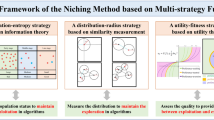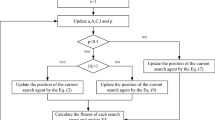Abstract
Most real-world optimization problems often come with multiple global optima or local optima. Therefore, increasing niching metaheuristic algorithms, which devote to finding multiple optima in a single run, are developed to solve these multimodal optimization problems. However, there are two difficulties urgently to be solved for most existing niching metaheuristic algorithms: how to set the niching parameter values for different optimization problems and how to jump out of the local optima efficiently. These two difficulties limit their practicality largely. Based on Whale Swarm Algorithm (WSA) we proposed previously, this paper presents a new multimodal optimizer named WSA with Iterative Counter (WSA-IC) to address these two difficulties. On the one hand, WSA-IC improves the iteration rule of the original WSA for multimodal optimization, which removes the need of specifying different values of attenuation coefficient for different problems to form multiple subpopulations, without introducing any niching parameter. On the other hand, WSA-IC enables the identification of extreme points during the iterations relying on two new parameters (i.e., stability threshold \(T_{\mathrm{s}}\) and fitness threshold \(T_{\mathrm{f}}\)), to jump out of the located extreme points. Moreover, the convergence of WSA-IC is proved. Finally, the proposed WSA-IC is compared with several niching metaheuristic algorithms on CEC2015 niching benchmark test functions and on five additional high-dimensional multimodal functions. The experimental results demonstrate that WSA-IC statistically outperforms other niching metaheuristic algorithms on most test functions.











Similar content being viewed by others
References
Tasgetiren MF, Kizilay D, Pan Q-K, Suganthan PN (2017) Iterated greedy algorithms for the blocking flowshop scheduling problem with makespan criterion. Comput Oper Res 77:111–126
Lin G, Zhu W, Ali MM (2016) An effective hybrid memetic algorithm for the minimum weight dominating set problem. IEEE Trans Evol Comput 20(6):892–907
Zhang H, Cao X, Ho JKL, Chow TWS (2017) Object-level video advertising: an optimization framework. IEEE Trans Ind Inform 13(2):520–531
Ciancio C, Ambrogio G, Gagliardi F, Musmanno R (2016) Heuristic techniques to optimize neural network architecture in manufacturing applications. Neural Comput Appl 27(7):2001–2015
Şevkli AZ, Güler B (2017) A multi-phase oscillated variable neighbourhood search algorithm for a real-world open vehicle routing problem. Appl Soft Comput 58:128–144
Yi J, Li X, Chu C-H, Gao L (2016) Parallel chaotic local search enhanced harmony search algorithm for engineering design optimization. J Intell Manuf. https://doi.org/10.1007/s10845-016-1255-5
Raja MAZ, Ahmed U, Zameer A, Kiani AK, Chaudhary NI (2017) Bio-inspired heuristics hybrid with sequential quadratic programming and interior-point methods for reliable treatment of economic load dispatch problem. Neural Comput Appl. https://doi.org/10.1007/s00521-017-3019-3
Zhang H, Llorca J, Davis CC, Milner SD (2012) Nature-inspired self-organization, control, and optimization in heterogeneous wireless networks. IEEE Trans Mob Comput 11(7):1207–1222
Li X (2010) Niching without niching parameters: particle swarm optimization using a ring topology. IEEE Trans Evol Comput 14(1):150–169
De Jong KA (1975) Analysis of the behavior of a class of genetic adaptive systems. https://books.google.co.in/books?id=4b9bNQcL6wMC
Goldberg DE, Richardson J (1987) Genetic algorithms with sharing for multimodal function optimization. In: Genetic algorithms and their applications: proceedings of the second international conference on genetic algorithms. Lawrence Erlbaum, Hillsdale, NJ, pp 41–49
Yin X, Germay N (1993) A fast genetic algorithm with sharing scheme using cluster analysis methods in multimodal function optimization. In: Artificial neural nets and genetic algorithms. Springer, pp 450–457
Harik GR (1995) Finding multimodal solutions using restricted tournament selection. In: ICGA, pp 24–31
Bessaou M, Pétrowski A, Siarry P (2000) Island model cooperating with speciation for multimodal optimization. In: International conference on parallel problem solving from nature. Springer, pp 437–446
Deb K, Goldberg DE (1989) An investigation of niche and species formation in genetic function optimization. In: Proceedings of the 3rd international conference on genetic algorithms. Morgan Kaufmann Publishers Inc., pp 42–50
Kennedy J, Mendes R (2002) Population structure and particle swarm performance. In: Proceedings of the 2002 congress on evolutionary computation, 2002. CEC’02. IEEE, pp 1671–1676
Li X, Epitropakis M, Deb K, Engelbrecht A (2016) Seeking multiple solutions: an updated survey on niching methods and their applications. IEEE Trans Evol Comput 21(4):518–538
Thomsen R (2004) Multimodal optimization using crowding-based differential evolution. In: Congress on evolutionary computation, 2004. CEC2004. IEEE, pp 1382–1389
Mahfoud SW (1992) Crowding and preselection revisited. Urbana 51:61801
Mengshoel OJ, Goldberg DE (1999) Probabilistic crowding: deterministic crowding with probabilistic replacement. In: Proceedings of the genetic and evolutionary computation conference (GECCO-99), p 409
Ursem RK (1999) Multinational evolutionary algorithms. In: Proceedings of the 1999 congress on evolutionary computation, 1999. CEC 99. IEEE, pp 1633–1640
Stoean CL, Preuss M, Stoean R, Dumitrescu D (2007) Disburdening the species conservation evolutionary algorithm of arguing with radii. In: Proceedings of the 9th annual conference on Genetic and evolutionary computation. ACM, pp 1420–1427
Zeng B, Gao L, Li X (2017) Whale swarm algorithm for function optimization. In: Huang D-S, Bevilacqua V, Premaratne P, Gupta P (eds) Intelligent computing theories and application: 13th international conference, ICIC 2017, Liverpool, UK, August 7–10, 2017, Proceedings, Part I. Springer, Cham, pp 624–639. https://doi.org/10.1007/978-3-319-63309-1_55
Das S, Maity S, Qu B-Y, Suganthan PN (2011) Real-parameter evolutionary multimodal optimizationąłA survey of the state-of-the-art. Swarm Evol Comput 1(2):71–88
Li J-P, Balazs ME, Parks GT, Clarkson PJ (2002) A species conserving genetic algorithm for multimodal function optimization. Evol Comput 10(3):207–234
Li X (2005) Efficient differential evolution using speciation for multimodal function optimization. In: Proceedings of the 7th annual conference on Genetic and evolutionary computation. ACM, pp 873–880
Li X (2004) Adaptively choosing neighbourhood bests using species in a particle swarm optimizer for multimodal function optimization. In: Genetic and evolutionary computation GECCO 2004. Springer, pp 105–116
Beasley D, Bull DR, Martin RR (1993) A sequential niche technique for multimodal function optimization. Evol Comput 1(2):101–125
Brits R, Engelbrecht AP, Van den Bergh F (2002) A niching particle swarm optimizer. In: Proceedings of the 4th Asia-Pacific conference on simulated evolution and learning. Orchid Country Club, Singapore, pp 692–696
Stoean C, Preuss M, Stoean R, Dumitrescu D (2010) Multimodal optimization by means of a topological species conservation algorithm. IEEE Trans Evol Comput 14(6):842–864
Deb K, Saha A (2010) Finding multiple solutions for multimodal optimization problems using a multi-objective evolutionary approach. In: Proceedings of the 12th annual conference on genetic and evolutionary computation. ACM, pp 447–454
Li L, Tang K (2015) History-based topological speciation for multimodal optimization. IEEE Trans Evol Comput 19(1):136–150
Liang JJ, Qin AK, Suganthan PN, Baskar S (2006) Comprehensive learning particle swarm optimizer for global optimization of multimodal functions. IEEE Trans Evol Comput 10(3):281–295
Li X (2007) A multimodal particle swarm optimizer based on fitness Euclidean-distance ratio. In: Proceedings of the 9th annual conference on Genetic and evolutionary computation. ACM, pp 78–85
Qu B-Y, Suganthan PN, Liang J-J (2012) Differential evolution with neighborhood mutation for multimodal optimization. IEEE Trans Evol Comput 16(5):601–614
Qu B-Y, Suganthan P, Das S (2013) A distance-based locally informed particle swarm model for multimodal optimization. IEEE Trans Evol Comput 17(3):387–402
Yazdani S, Nezamabadi-pour H, Kamyab S (2014) A gravitational search algorithm for multimodal optimization. Swarm Evol Comput 14:1–14
Wang Y, Li H-X, Yen GG, Song W (2015) MOMMOP: multiobjective optimization for locating multiple optimal solutions of multimodal optimization problems. IEEE Trans Cybern 45(4):830–843
http://www.ntu.edu.sg/home/EPNSugan/index_files/CEC2015/CEC2015.htm
Funding
This study was funded by the National Natural Science Foundation of China (NSFC) (51825502, 51775216, and 51721092), Natural Science Foundation of Hubei Province (2018CFA078), and the Program for HUST Academic Frontier Youth Team.
Author information
Authors and Affiliations
Corresponding author
Ethics declarations
Conflict of interest
We declare that we have no financial and personal relationships with other people or organizations that can inappropriately influence our work, there is no professional or other personal interest of any nature or kind in any product, service and/or company that could be construed as influencing the position presented in, or the review of, the manuscript entitled “Whale swarm algorithm with the mechanism of identifying and escaping from extreme points for multimodal function optimization.”
Additional information
Publisher's Note
Springer Nature remains neutral with regard to jurisdictional claims in published maps and institutional affiliations.
Rights and permissions
About this article
Cite this article
Zeng, B., Li, X., Gao, L. et al. Whale swarm algorithm with the mechanism of identifying and escaping from extreme points for multimodal function optimization. Neural Comput & Applic 32, 5071–5091 (2020). https://doi.org/10.1007/s00521-018-3949-4
Received:
Accepted:
Published:
Issue Date:
DOI: https://doi.org/10.1007/s00521-018-3949-4




